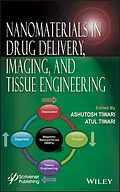This comprehensive volume provides the reader valuable insight into the major areas of biomedical nanomaterials, advanced nanomedicine, nanotheragnostics, and cutting-edge nanoscaffolds.
The ability to control the structure of materials allows scientists to accomplish what once appeared impossible before the advent of nanotechnology. It is now possible to generate nanoscopic self-assembled and self-destructive robots for effective utilization in therapeutics, diagnostics, and biomedical implants. Nanoscopic therapeutic systems incorporate therapeutic agents, molecular targeting, and diagnostic imaging capabilities and they have emerged as the next generation of multifarious nanomedicine to improve the therapeutic outcome including chemo and translational therapy.
Nanomaterials in Drug Delivery, Imaging, and Tissue Engineering comprises fifteen chapters authored by senior scientists, and is one of the first books to cover nanotheragnostics, which is the new developmental edge of nanomedicine combining both diagnostic and therapeutic elements at the nano level. This large multidisciplinary reference work has four main parts: biomedical nanomaterials; advanced nanomedicine; nanotheragnostics; and nanoscaffolds technology.
This groundbreaking volume also covers:
* Multifunctional polymeric nanostructures for therapy and diagnosis
* Metalla-assemblies acting as drug carriers
* Nanomaterials for management of lung disorders and drug delivery
* Responsive polymer-inorganic hybrid nanogels for optical sensing, imaging, and drug delivery
* Core/shell nanoparticles for drug delivery and diagnosis
* Theranostic nanoparticles for cancer imaging and therapy
* Magnetic nanoparticles in tissue regeneration
* Core-sheath fibers for regenerative medicine
Autorentext
Ashutosh Tiwari is an assistant professor of
nanobioelectronics at the Biosensors and Bioelectronics Centre,
IFM-Linköping University, Editor-in-Chief of Advanced
Materials Letters, and a materials chemist. He graduated from
the University of Allahabad, India. He has published more than 125
articles and patents as well as authored/edited in the field of
materials science and technology. Dr.Tiwari received the 2011
"Innovation in Materials Science Award and Medal" during the
International Conference on Chemistry for Mankind: Innovative Ideas
in Life Sciences.
Atul Tiwari is an associate researcher at the Department
of Mechanical Engineering in the University of Hawaii, USA. He
received his PhD in Polymer Science and earned the Chartered
Chemist and Chartered Scientist status from the Royal Society of
Chemistry, UK. His areas of research interest include the
development of silicones and graphene materials for various
industrial applications. Dr. Tiwari has invented several
international patents pending technologies that have been
transferred to industries. He has been actively engaged in various
fields of polymer science, engineering, and technology and has
published more than fifty peer-reviewed journal papers, book
chapters, and books related to material science.
Inhalt
Preface xv
Part I: Biomedical nanomaterials
1 Nanoemulsions: Preparation, Stability and Application in Biosciences 1
Thomas Delmas, Nicolas Atrux-Tallau, Mathieu Goutayer, SangHoon Han, Jin Woong Kim, and Jérôme Bibette
1.1 Introduction 2
1.2 Nanoemulsion:A Thermodynamic Denition and Its Practical Implications 5
1.2.1 Generalities on Emulsions 5
1.2.2 Nanoemulsion vs. Microemulsion, a Thermodynamic Denition 6
1.3 Stable Nanoemulsion Formulation 9
1.3.1 Nanoemulsion Production 9
1.3.2 Nanoemulsion Stability Rules 11
1.3.3 Nanoemulsion Formulation Domain 16
1.3.4 Conclusion on the Formulation of Stable Nanoemulsions 21
1.4 Nanoencapsulation in Lipid Nanoparticles 21
1.4.1 Aim ofActive Encapsulation 21
1.4.2 Lipid Complexity and Inuence of Their Physical State 23
1.4.3 Amorphous Lipids for a Large Range of Encapsulated Molecules 27
1.4.4 Lipids Viscosity and Release 31
1.4.5 Conclusion on the Use ofAmorphous Lipid Matrices for Control OverActive Encapsulation and Release 34
1.5 Interactions between Nanoemulsions and the Biological Medium: Applications in Biosciences 35
1.5.1 Nanoemulsion Biocompatibility 35
1.5.2 Classical TargetingApproach by Chemical Grafting Example of Tumor Cell Targeting by Crgd Peptide for Cancer Diagnosis and Therapy 38
1.5.3 New 'No Synthesis Chemistry'Approach Example of Pal-KTTKS andAsiaticoside Targeting for CosmeticActives Delivery 41
1.5.4 Conclusion on Nanoemulsions Application in Biosciences 46
1.6 General Conclusion 47
References 48
2 Multifunctional Polymeric Nanostructures for Therapy and Diagnosis 57
Angel Contreras-García and Emilio Bucio
2.1 Introduction 58
2.2 Polymeric-based Core-shell Colloid 61
2.3 Proteins and Peptides 64
2.4 Drug Conjugates and Complexes with Synthetic Polymers 65
2.5 Dendrimers, Vesicles, and Micelles 67
2.5.1 Dendrimers 67
2.5.2 Vesicles 68
2.5.3 Micelles 70
2.6 Smart Nanopolymers 71
2.6.1 Temperature and pH Stimuli-responsive Nanopolymers 72
2.6.2 Hydrogels 72
2.6.3 Stimuli Responsive Biomaterials 73
2.6.4 Interpenetrating Polymer Networks 74
2.7 Stimuli Responsive Polymer-metal Nanocomposites 75
2.8 Enzyme-responsive Nanoparticles 78
Acknowledgements 83
References 83
3 Carbon Nanotubes: Nanotoxicity Testing and Bioapplications 97
R. Sharma and S. Kwon
3.1 Introduction 98
3.1.1 What is Nanotoxicity of Nanomaterials? 98
3.2 Historical Review of Carbon Nanotube 99
3.3 Carbon Nanotubes (CNTs) and Other Carbon Nanomaterials 100
3.3.1 Physical Principles of Carbon Nanotube Surface Science 102
3.4 Motivation Combining Nanotechnology and Surface Science with Growing Bioapplications 104
3.5 Cytotoxicity Measurement and Mechanisms of CNT Toxicity 111
3.1.6 In Vivo Studies on CNT Toxicity 113
3.1.7 Inammatory Mechanism of CNT Cytoxicity 114
3.1.8 Characterization and Toxicity of SWCNT and MWCNT Carbon Nanotubes 116
3.6 MSCs Differentiation and Proliferation on Different Types of Scaffolds 120
3.6.1 An In Vivo Model CNT-Induced Inammatory Response in Alveolar Co-culture System 122
3.6.2 Static Model: 3-Dimensional Tissue Engineered Lung 124
3.6.3 Dynamic Model: Integration of 3D Engineered Tissues into Cyclic Mechanical Strain Device 126
3.6.4 In Vivo MR Microimaging Technique of Rat Skin Exposed to CNT 127
3.7 New Lessons on CNT Nanocomposites 130
3.8 Conclusions 135
Part II: Advanced nanomedicine
4 Discrete Metalla-Assemblies as Drug Delivery Vectors 149
Bruno Therrien
4.1 Introduction 149
4.2 Complex-in-a-Complex Systems 150
4.3 Encapsulation of Pyrenyl-functionalized Derivatives 155
4....
